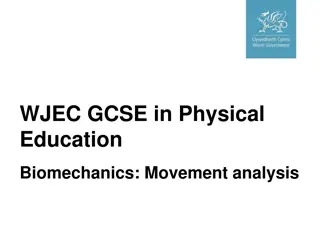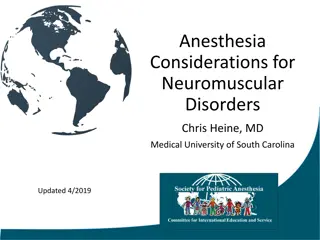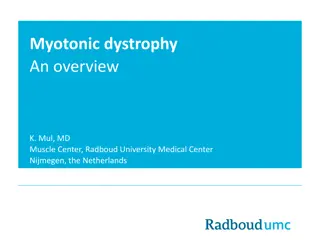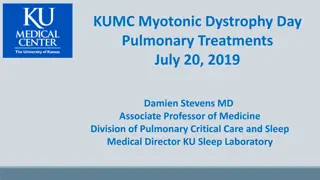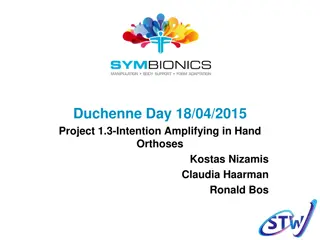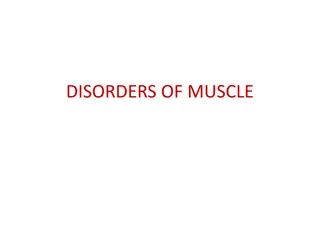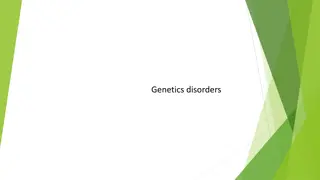Duchenne Muscular Dystrophy: Historical Background and Clinical Features
Duchenne Muscular Dystrophy (DMD) is a progressive and hereditary degenerative disease of skeletal muscles, primarily affecting males. The historical background includes early descriptions by key figures such as Mr. Little and Meryon, leading up to Duchenne's clear characterization of the disease. Clinical features typically manifest in early childhood, with symptoms like muscle weakness, difficulty in movement, and a distinct gait pattern. The etiology of DMD is linked to mutations in the dystrophin gene on the X chromosome.
Download Presentation

Please find below an Image/Link to download the presentation.
The content on the website is provided AS IS for your information and personal use only. It may not be sold, licensed, or shared on other websites without obtaining consent from the author.If you encounter any issues during the download, it is possible that the publisher has removed the file from their server.
You are allowed to download the files provided on this website for personal or commercial use, subject to the condition that they are used lawfully. All files are the property of their respective owners.
The content on the website is provided AS IS for your information and personal use only. It may not be sold, licensed, or shared on other websites without obtaining consent from the author.
E N D
Presentation Transcript
DMD Dr. Nawaj Pathan Dept of Neurophysiotherapy MGM Institute of Physiotherapy Chh. Sambhajinagar
Historical background The muscular dystrophies are a group of Progressive, Hereditary, Degenerative disease of skeletal muscles. The word dystrophies should be reserved for the purely degenerative muscular disease of hereditary type and all the other progressive diseases of muscle should be referred to as Myopathies or polymyopathies. Following are the criteria's to distinguish other degenerative diseases are- The symmetrical distribution of muscular weakness & atrophy. Intact sensations Preservations of cutaneous reflexes
Historical background The isolated cases of muscular dystrophies had been reported earlier. The description was made between myopathic and neuropathic disease. In 1843-44, Mr. Little had described what appears to be in muscular dystrophies- in his lectures at Royal orthopedic hospital.
Meryon in 1852 gave first clear description of progressive weakness & atrophy of muscles in young boys with intact spinal cord & nerves. This fact led him to propose a theory that Idiopathic disease of muscles In 1855, the French neurologist Duchenne described the progressive muscular atrophy of childhood 'that now bears his name.
In 1861 he postulated it as a hypertrophic paraplegia of infancy was recognized as a distinct syndrome, recognized that the disease was muscular in origin and restricted to males. Gowers in 1879 gave a masterful account of 21 personally observed cases and called attention to the characteristic way in which such patients arose from the floor (Gowers sign).
Etiology Over the years there have been no of theories concerning the pathogenesis of muscular dystrophies as a whole and DMD in particular. Abnormal gene on the X chromosome and of its gene product, dystrophin is responsible for DMD. Mutation of dystrophin is the primary cause of DMD
Clinical Features Only males are affected. Duchenne muscular dystrophy is usually recognized by the third year of life and almost always before the sixth year. They appear to be less active than usual and are prone to falls. Increasing difficulty in walking, running, and climbing stairs, swayback, and waddling gait become ever more obvious as time passes. The iliopsoas, quadriceps, and gluteal muscles are involved initially; then the pretibial muscles get weak.
Enlargement of the calves and certain other muscles is progressive in the early stages of the disease. The enlarged muscles have a firm, resilient ( rubbery ) feel and as a rule are slightly less strong and more hypotonic than healthy ones (pseudo-hypertrophy). Muscles of the pelvic girdle, lumbosacral spine, and shoulders become weak and wasted, accounting for certain clinical peculiarities. Weakness of abdominal and paravertebral muscles accounts for a lordotic posture and protuberant abdomen when standing and the rounded back when sitting.
Bilateral weakness of the extensors of the knees and hips interferes with equilibrium and with activities such as climbing stairs or rising from a chair or from a stooped posture. In rising from the ground, the child first assumes a four point position by extending the arms and legs to the fullest possible extent and then works each hand alternately up the corresponding thigh(Gowers sign) In standing and walking, the patient places his feet wide apart in order to increase his base of support.( straddles as he stands and waddles as he walks. )
Many affected boys have a tendency to walk on their toes as a consequence of contractures in the gastrocnemeii muscles. Weakening of the muscles that fix the scapulae to the thorax (serratus anterior, lower trapezius, rhomboids) causes a winging of the scapulae. Later, weakness and atrophy spread to the muscles of the legs and forearms. The muscles that are selectively affected include the neck flexors, wrist extensors, Brachioradialis, costal part of the pectoralis major, latissimus dorsi, biceps, triceps, anterior tibial, and peroneal muscles.
The ocular, facial, bulbar, and hand muscles are usually spared, although weakness of the facial & sternocleidomastoid muscles and of the diaphragm occurs in the late stages of the disease. The space between the lower ribs and iliac crests diminishes due to involvement of the abdominal muscles. The hamstring muscles become permanently shortened because of a lack of counteraction of the weaker quadriceps muscles.
Similarly, contractures occur in the hip flexors because of the relatively greater weakness of hip extensors and abdominal muscles. This leads to a pelvic tilt and compensatory lordosis to maintain standing equilibrium. The consequences of these contractures account for the habitual posture of the patient with Duchenne dystrophy: lumbar lordosis, hip flexion and abduction, knee flexion, and plantar flexion. These contractures contribute importantly to the eventual loss of ambulation.
Scoliosis- develop due to unequal weakening of the paravertebral muscles The tendon reflexes are diminished and then lost as muscle fibers disappear, the ankle reflexes being the last to go. Smooth muscles are spared, but the heart is usually affected Various types of arrhythmia may appear, on ECG prominent R waves are common.
Prognosis Death is usually the result of pulmonary infections and respiratory failure and, sometimes, of cardiac decompensation. These patients usually survive until late adolescence. 20 to 25 % of patients live beyond the twenty-fifth year, last years of life are spent in a wheelchair; finally the patient becomes bedfast.


